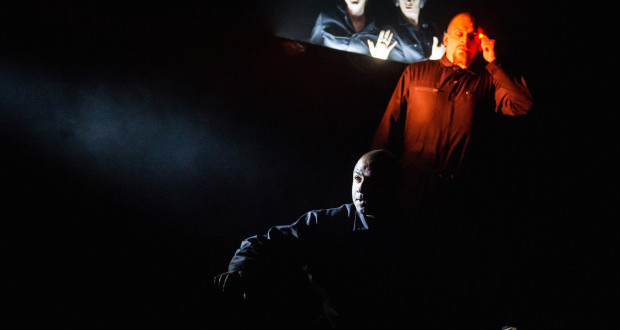Pros: Impressive use of technology and a thought provoking premise with outstanding talent and creative storytelling.
Cons: None. This is an absolutely flawless production that pushes the boundaries of progressive theatre. Set in a dystopian world where the government monitors our thoughts; we see the family who originated this nightmare through sound, light and movement.
Summary
Rating
Unmissable
The Pit is an intimate black box theatre in the depths of The Barbican. At the start of the show, an announcement warns us that the ushers will be watching us at all times should we have any trouble with flashing lights. This announcement, whilst concerned with health and safety on the surface, suitably forecasts the world of the play where the government monitors the thoughts of every citizen.
Writer and director George Mann, Light is inspired by Edward Snowden’s revelations of government spying, giving us a world where technology is king and the government supposedly keeps us safe from terrorism. The story follows Agent Dearden in a world where speech is redundant, as every human being has an implant that allows him or her to transmit thoughts directly to the receiver’s brain. Dearden works for the government, for whom he goes on missions to capture those in illegal disconnection clinics having their implants removed. These clinics and their doctors are supported by the rebel faction and the government seeks to capture their unknown leader.
Initially, the only distinct character we discover is Dearden. With everyone’s thoughts connected, there is little individual personality. After Dearden captures as unknown terrorist and enters her Mind Space to discover her secrets, we find out the world as it is now goes back to one couple. Inventor Cass transmitted the first thought to her husband on 2 May, 2081 telling him that she loved him. This innocent technology comes to be abused by Cass’s husband, so she leaves him and their infant son. The government, lead by Cass’s husband, starts using the implants to transmit information directly into people’s heads and to go into anyone’s “Mind Space” as they see fit. As Dearden delves into the depths of the woman’s mind, we discover both her and Dearden’s pasts intertwine.
Whilst the story itself is typical example dystopian Big Brother fare, it balances a wider worldview with an intimate portrayal of one family. What makes this production truly compelling and unlike anything I have ever seen is its use of light and sound. Rather than using the theatre’s lights, the performers manipulate the space and the audience’s perception using a combination of LED strips, torches and light-up thumb tips. Though this sounds quite simple, the detail and creativity employed is astounding. The lighting (with consultation provided by Matthew Leventhall) is accompanied by Chris Bartholomew’s flawless electronic soundtrack. The actors use precise and detailed movements to indicate character, and location, often appearing to manipulate the beams of light. All roles and the lighting were performed by Charlotte Dubery, Matthew Gurney, Robin Guiver, Deborah Pugh and Michael Sharman. Surtitles, rather than speech, contribute to the lighting element and add character and plot information, though this is used only when absolutely necessary.
Another unique feature is that the production was developed with Deaf actor Matthew Gurney. Combined with more traditional physical theatre influences, Gurney contributed the use of a technique called Visual Vernacular, “a form of physical theatre developed by Deaf artists for Deaf and Hearing audiences.”
By the end of the production, I was in utter awe of the display of brilliant skill before me that manages to evolve the fields of physical and technical theatre. I was also filled by the uneasy foreboding of how society could evolve in parallel. The end of the narrative leaves the audience questioning whose perspective is real; an unsettling feeling. It is a visual, aural and mental feast.
This production is part of the London International Mime Festival for a short time and then goes on tour nationwide. To experience innovative theatre that takes the art form to new heights, see this show.
Director: George Mann
Producer: Theatre Ad Infinitum
Booking Link:
London International Mime Festival: http://www.barbican.org.uk/theatre/event-detail.asp?ID=16915
National Tour Schedule: http://www.theatreadinfinitum.co.uk/light-2014/
Booking Until: 24 January 2015
 Everything Theatre Reviews, interviews and news for theatre lovers, London and beyond
Everything Theatre Reviews, interviews and news for theatre lovers, London and beyond




2 comments
Pingback: The Xmas Carol, Old Red Lion Theatre | The Play's The Thing UK
Pingback: Top Ten Shows of 2015 | The Play's The Thing UK